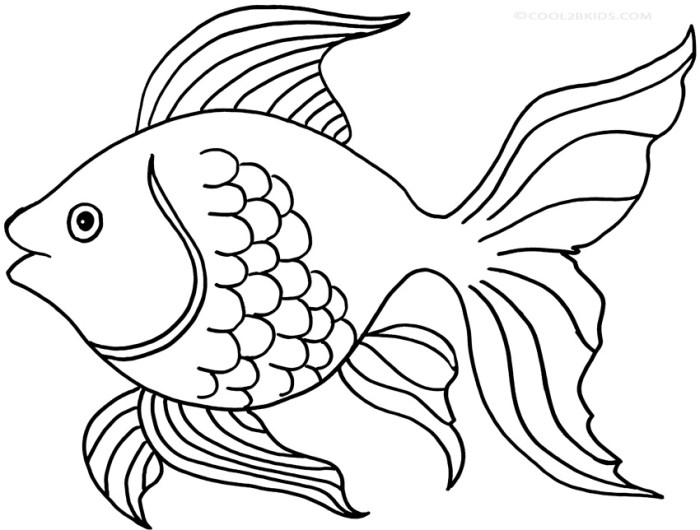Designing the Coloring Page Layout: An Animal That Eats Fish Coloring Page

An animal that eats fish coloring page – Creating a visually appealing and engaging coloring page requires careful consideration of layout and design elements. The goal is to provide a fun and stimulating activity for children while maintaining a clear and organized structure. This section details a layout for a coloring page featuring an animal that eats fish, using a simple and effective 2×2 table structure.The use of a 2×2 table allows for a clear division of space, making it easy for children to focus on different areas of the page without feeling overwhelmed.
Each quadrant will be dedicated to a specific element, creating a balanced and visually appealing composition.
Table Layout for the Coloring Page, An animal that eats fish coloring page
A 2×2 table provides a structured approach to organizing the coloring page elements. Each cell will represent a key visual component: the animal, the water, aquatic plants, and other details. This layout ensures a balanced distribution of space and visual interest.
| Animal This section will feature the main animal, perhaps a heron, otter, or pelican, depicted in a dynamic pose, ready to catch its prey. The animal should be large enough to allow for detailed coloring but not so large as to overwhelm the other elements. Consider including subtle lines to guide the child’s coloring and ensure proper proportions. |
Water This area represents the aquatic environment. It could feature simple wavy lines to suggest movement and depth. Consider incorporating different shades of blue and green to create visual interest. Adding small bubbles or ripples can enhance the scene’s dynamism. |
| Plants This section will depict aquatic plants like reeds or water lilies. Simple shapes and lines will suffice, allowing children to color them in with various shades of green and other suitable colors. The plants should complement the overall scene, not compete with the main animal. |
Other Details This section allows for additional elements to enhance the scene, such as small fish, rocks, or other details relevant to the aquatic environment. These elements should be small and simple, avoiding clutter and maintaining visual balance. Examples could include small, stylized fish or simple rocks near the water’s edge. |
Creating Aquatic Background Elements

Designing a captivating underwater scene for your fish-eating animal coloring page requires careful consideration of the aquatic environment. The background elements should be simple enough for young children to color but detailed enough to create a sense of depth and wonder. A well-designed background will enhance the overall appeal and educational value of the coloring page.
Simple yet engaging aquatic background elements can transform a basic coloring page into a vibrant underwater world. Think about the textures and shapes of common underwater features to create a realistic yet playful setting for your fish-eating animal. Color variations will add to the visual interest and allow for creative expression from the young colorist.
Seaweed Depictions
Seaweed offers a great opportunity to introduce organic, flowing lines into the design. Consider depicting various types of seaweed, each with unique characteristics. One could be long and flowing, with thin, ribbon-like strands that undulate across the page, suggesting movement in the water. Its color could range from deep greens to lighter, almost yellowish-greens, with subtle shading to indicate depth and texture.
Another seaweed type could be shorter and bushier, with a more textured appearance, perhaps resembling a clump of feathery fronds, colored in a darker, richer green, with hints of brown or olive green. This variety adds visual complexity and depth to the scene.
Rock Formations
Rocks provide a sense of stability and contrast to the flowing seaweed. Simple, rounded rocks are ideal for children to color. Consider showing a variety of rock sizes, some large and imposing, others small and scattered across the seabed. Color variations could include shades of gray, brown, and even hints of reddish-brown or black to create a sense of depth and realism.
The texture of the rocks can be implied through shading and line work, suggesting a rough, uneven surface. A smooth, polished rock might have a lighter color and smoother lines.
Bubble Clusters
Bubbles add a playful touch and suggest movement in the water. Design them in clusters of varying sizes, some large and some small, to create a dynamic effect. They should be simple circles, perhaps with a slight shading to suggest a three-dimensional form. The color should be a light, almost transparent blue or white, allowing the underlying colors to show through.
The placement of the bubbles should be strategic, perhaps rising from the seabed or swirling around the fish-eating animal, adding a sense of life and energy to the scene.
Looking for a fun activity that combines creativity and learning? An animal that eats fish coloring page, like an otter or a heron, can be a great starting point. You can find a wide variety of options, including these fantastic illustrations, by checking out this extensive collection of free printable animal coloring pages. These pages offer a chance to explore different aquatic predators and enhance your understanding of their diets while enjoying a relaxing coloring session.
So grab your crayons and start coloring your favorite fish-eating animal!
